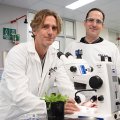A looming health crisis that has the potential to affect millions of people around the world is the focus of an ongoing University of Queensland research project.
Associate Professor Jack Ng has been studying the impact and scale of chronic arsenic poisoning around the world, particularly through the use of contaminated ground water.
His work was recently highlighted in the respected science magazine New Scientist.
Dr Ng, from UQ’s Faculty of Health Sciences, is the program manager of metals and metalloids research at EnTox (formerly the National Research Centre for Environmental Toxicology).
He found 50 million people are potentially at risk from this sort of poisoning in countries such as Bangladesh and India where the use of tube wells for drinking water is highly prevalent.
“The extent of arsenic contamination means tens of millions of people are affected,” he said.
“And the burden that is going to place on the health care system is going to be huge in the coming years.”
While arsenic is a naturally occurring substance the problem stems from the increasing use of groundwater as a water source instead of surface water, which in developing nations can be unfit for drinking.
By drinking the contaminated water, people put themselves at risk of developing skin lesions such as hyper- and hypo-pigmentation, and hyper-keratosis, cardiovascular disease, diabetes, cancers of the skin, lung and bladder.
“There are millions of wells out there with new ones being dug every day and testing them all for contamination is virtually impossible,” he said.
But Dr Ng said the most worrying part of his research, which was published in Chemosphere (Vol 52, 2003, 1353-1359), was the extent of the contamination.
“The latest results are showing countries like China, Vietnam, Nepal and even the United States are at serious risk,” he said.
“Even Australia has contaminated water but the difference is we have the technology to treat the water.
“Part of the problem in places like Bangladesh is finding a low tech water treatment that is workable at a village level.
“And then there are the problems where people will say the water that is clean and treated doesn’t taste the same as the water they are used to drinking and will continue to go to a contaminated well.”
Despite the scale of the problem, Dr Ng said the problem was fixable but it would be a challenging prospect.
Media: For more information contact Associate Professor Jack Ng at EnTox (+61 7 3274 9020, email j.ng@uq.edu.au) or Andrew Dunne at UQ Communications (+61 7 3365 2802, email a.dunne@uq.edu.au).
.jpg)



